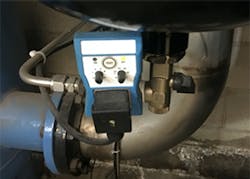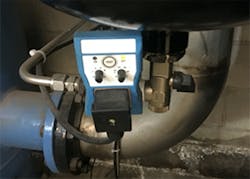Got water problems in your compressed air system? Check your temperatures
Here’s a common scenario: A customer is complaining about water in their compressed air. They have had the service guy in numerous times to check the air dryer, to no avail. Water still keeps pouring out of the pipes.
A compressed air auditor visits the plant and tries to open the compressor room door but it is being held closed by the negative pressure in the room. He finally enters with a yank on the handle and is hit by a wall of heat. Inside are hissing timer drains on every filter, dryer, compressor and tank, with a few more thrown in for good measure in piping low spots. These are all set for long blows every couple of minutes to try to rid the system of water.
The auditor feels the discharge of the compressor and almost burns his hand. This tells him it’s not a dryer problem – there is a serious problem with heat.
Overheating of the compressed air input to an air dryer is a problem. Most people don’t realize that every 20° increase in compressed air temperature doubles the amount of water vapor the air dryer must process. Therefore, the control of the discharge temperature is important if you always want dry air.
All air dryers have temperature and pressure ratings. This is commonly the three 100’s. Ratings of 100°F inlet air temperature, 100°F ambient, and 100 psi inlet are common for refrigerated air dryers. If the temperatures are higher than the rating, or pressure lower, then the dryer must be upsized to be able to process the water vapor volume under extreme conditions.
Do you need to upsize your dryer? Not necessarily, if you can control your discharge temperatures. Well-designed cooling systems and clean compressor coolers (either water or air cooled) are essential to keep the dryer running smoothly. A good check is to feel the discharge temperature (or shoot it with an IR gun); if it is uncomfortably hot to touch (above 100°F) then you know you have cooling problems.
Good cooling systems keep temperatures below the rating of the air dryers, even on the hottest summer day after a rainstorm, the worst-case scenario. If correct your cooling problem you can turn down all those condensate drains, or better yet replace them with airless drains and save yourself some cash on your energy bill.


